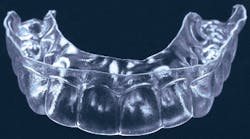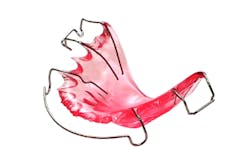A protocol to help patients keep their straight teeth for life using orthodontic retainers
Is it realistic for patients to want to keep their teeth perfectly straight forever? Dr. Curtis Andrews, an orthodontist in Butte, Montana, gives his professional opinion and explains how the different types of orthodontic retainers can be used together in a customized, long-term orthodontic retention protocol.
Editor's note: This article first appeared in DE's Breakthrough Clinical with Stacey Simmons, DDS, the clinical specialties newsletter created just for dentists. Browse our newsletter archives to find out more and subscribe here.
Among the many trends in current dental practice is the wonderful prevalence of individuals maintaining a full complement of teeth for their entire lives. It was once a foregone conclusion that eventually we would all lose our teeth and get dentures. But the mindset of our patients today is the exact opposite. Most everyone expects to keep their teeth forever. Further, we find that as patients expect to keep their teeth, they also expect that their teeth stay healthy, white, and straight indefinitely. Is it realistic to want to keep our teeth perfectly straight until the day we die? Absolutely! However, as with all other lifetime considerations, it will require some effort and maintenance to achieve this goal over a lifetime.
Orthodontic treatment modalities historically
The emphasis of much orthodontic treatment planning in days gone by was to treat in such a way that long-term stability could be achieved without the need for external retainers. For more than a century, various practitioners promoted specific treatment modalities that would achieve straight teeth and hopefully stay that way forever. Most orthodontic philosophical debates centered on this goal. All techniques could achieve perfect occlusion, but which results would stay? Extraction, nonextraction, expansion, two-phase treatment, functional appliances, third molar removal—all of these are purported to achieve a more stable result than the others. The skill of the practitioner and the treatment modality used were viewed as primary considerations in the stability of the long-term result.
ALSO BY DR. CURTIS ANDREWS ...
In the late 1990s, the University of Washington published several studies addressing the central question of which treatment method would provide the most long-term stability. (1) This landmark study, spanning 40 years and 800 patients, investigated all of the various categories—premolar extraction, expansion, lower incisor extraction, spacing, crowding, arch development, third molar removal, and untreated normal cases. The results were shocking. All of the categories showed a decrease in arch length, arch width, and an increase in mandibular incisor crowding. Which type of treatment leads to stable orthodontic results over the long term? None of them!
So, if we are intent on maintaining perfectly straight teeth for a lifetime, we will need to utilize retainers for a lifetime. When my patients ask, “How long do I have to wear my retainers?” my honest answer is, “For as long as you want to have straight teeth.”
MORE TO READ AND STUDY ...
Treatment considerations for the congenitally missing maxillary lateral incisor
How to prevent root resorption using the Golden Rule of Orthodontics
Fixed retainers
There are several different types of commonly used orthodontic retainers, and they fall into two broad categories: fixed and removable. Fixed retainers include wires that are bonded to the lingual surfaces of the anterior teeth. The wires can be made of thick-gauge stainless steel and attached only on the terminal teeth (usually the canines). This design allows easier flossing between the incisors. However, since each tooth is not bonded to the wire, the incisors will still be able to rotate. The movement of the teeth can result in undesirable relapse, which is a drawback of this design.
A more common variation of fixed retainer, called a bonded lingual retainer, uses a thinner, multistrand, braided, stainless-steel wire bonded individually to each tooth (figure 1). This is the most precise way to ensure that there is no incisor relapse or crowding. The trade-off is that a floss threader is required to floss under the retainer. Calculus and plaque buildup are increased in most lingual retainers. Over the years, there have been concerns that periodontal problems, bone loss, and increased caries would be associated with bonded lingual retainers. (2) Several recent long-term studies (up to 20 years of follow-up) have demonstrated that although there is increased calculus buildup on bonded lingual retainers, there is not an increase in periodontal problems, bone loss, or caries. (3) Lingual retainers may give the appearance of less-than-desirable oral hygiene, but they do not appear to cause any actual disease-related problems. (4)
Figure 1: Bonded lingual retainer (braided stainless steel)
Removable retainers
Removable retainers include acrylic and wire Hawley retainers, as well as clear vacuum-formed retainers (figures 2 and 3). They have the advantage of holding all the teeth—including posterior teeth and arch width. When used correctly, removable retainers can hold teeth perfectly straight and make brushing and flossing easier. The obvious disadvantage, of course, is that removable retainers are highly compliance dependent. If a patient becomes inconsistent in wearing the retainers, teeth can shift in a very short period of time—sometimes within a week or two. Research shows no difference in efficacy (5) or durability among the different types of removable retainers. (6)
Long-term retention protocol
So, what is the best way to help patients achieve a perfect smile that truly will last a lifetime? I recommend a combination approach using both fixed and removable retainers. An appropriate retention plan for most patients includes a fixed bonded lingual retainer from mandibular canine to canine, with each tooth bonded individually to a braided stainless-steel wire. In addition, a removable clear vacuum-formed retainer is made for both maxillary and mandibular arches. These retainers are worn full-time for two months, every night for a year, and then two-to-four nights a week indefinitely.
Regardless of the approach to orthodontic retention, it is critical to remember that a perfectly retained smile is only possible with a long-term retention protocol. If implemented correctly, we can truly achieve smiles that last a lifetime!
References
1. Little RM. Stability and relapse of mandibular anterior alignment: University of Washington studies. Semin Orthod. 1999;5(3):191-204.
2. Booth FA, Edelman JM, Proffit WR. Twenty-year follow-up of patients with permanently bonded mandibular canine-to-canine retainers. Am J Orthod Dentofacial Orthop. 2008;133(1):70-76. doi: http://dx.doi.org/10.1016/j.ajodo.2006.10.023.
3. Pandis N, Vlahopoulos K, Madianos P, Eliades T. Long-term periodontal status of patients with mandibular lingual fixed retention. Eur J Orthod. 2007;29(5):471-476. doi: http://dx.doi.org/10.1093/ejo/cjm042.
4. Al-Kuwari HM, Al Balbeesi HO, Al Thobiani S, bin Sogain M. Caries incidence in lower anterior teeth bonded with fixed orthodontic retainer. The Saudi Journal for Dental Research. 2015;6(3):3-8. doi: 10.1016/j.sjdr.2014.03.00.
5. Mai W, He J, Meng H, et al. Comparison of vacuum-formed and Hawley retainers: a systematic review. Am J Orthod Dentofacial Orthop. 2014;145(6):720-727. doi: http://dx.doi.org/10.1016/j.ajodo.2014.01.019.
6. Rowland H, Hichens L, Williams A, et al. The effectiveness of Hawley and vacuum-formed retainers: a single-center randomized controlled trial. Am J Orthod Dentofacial Orthop. 2007;132(6):730-737.
Editor's note: This article first appeared in DE's Breakthrough Clinical with Stacey Simmons, DDS, the clinical specialties newsletter created just for dentists. Browse our newsletter archives to find out more and subscribe here.




